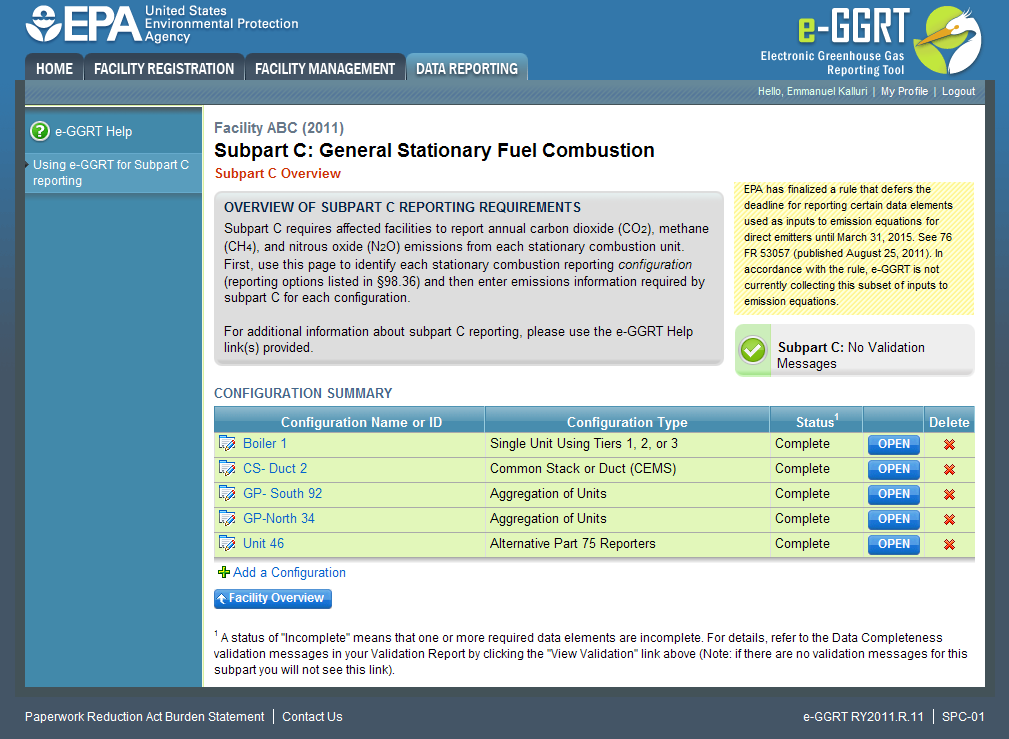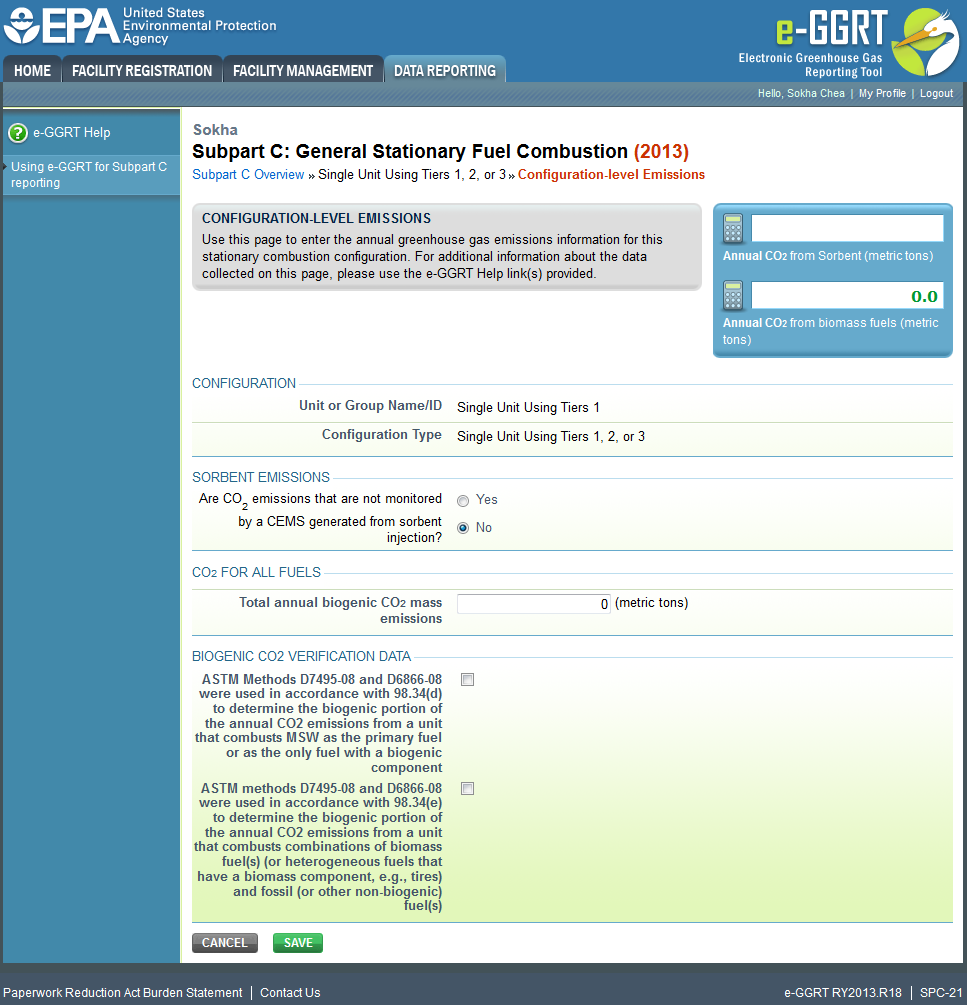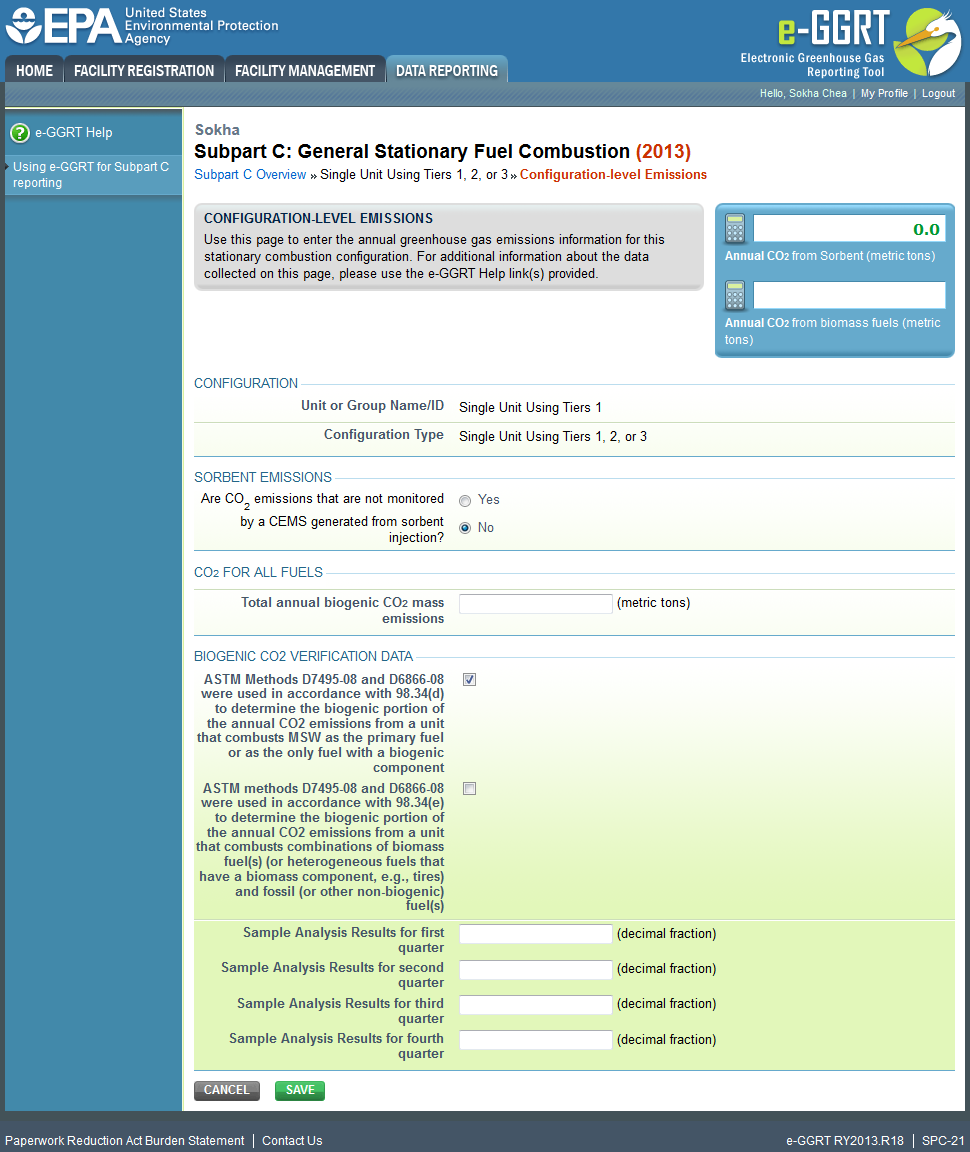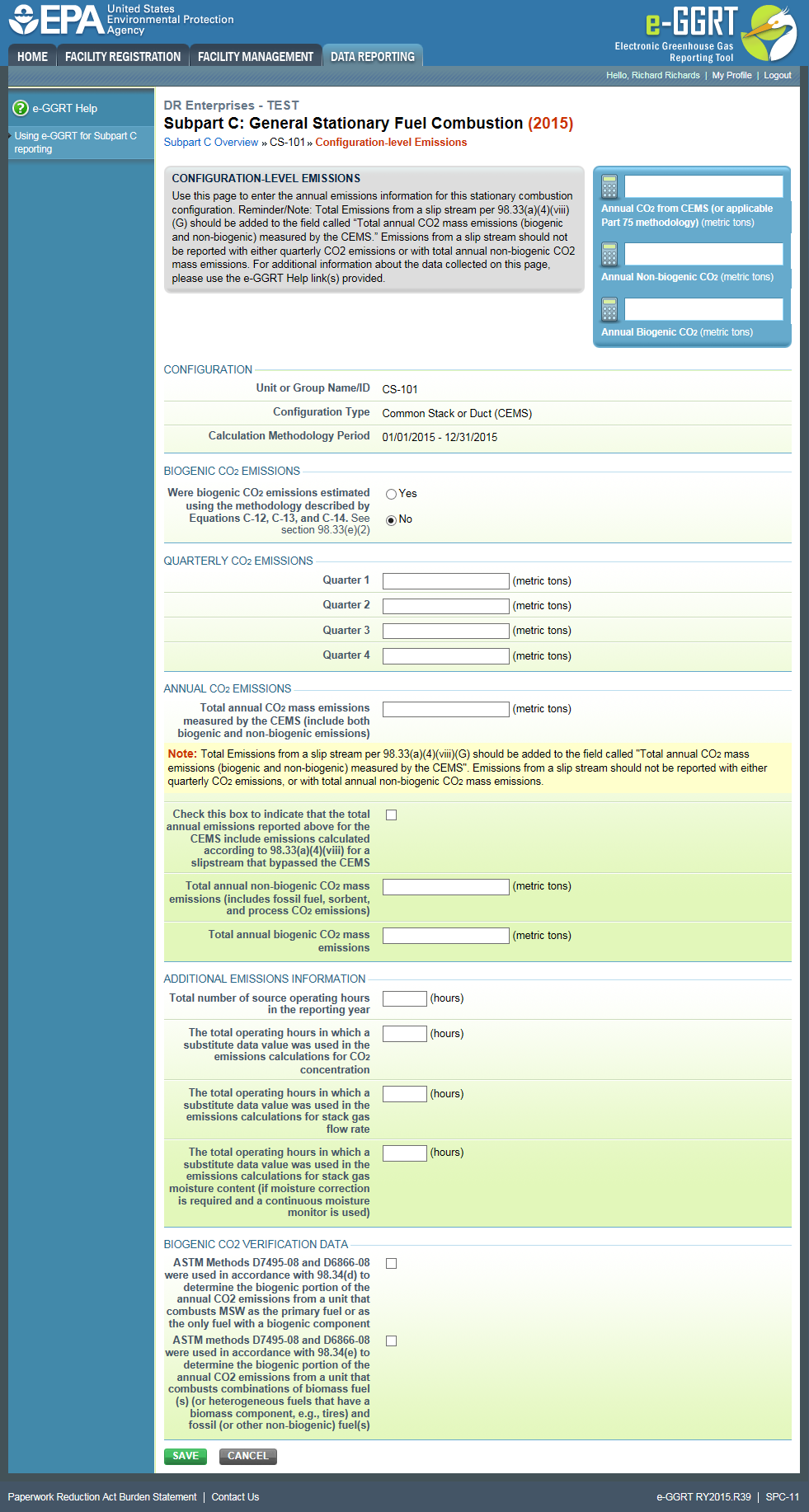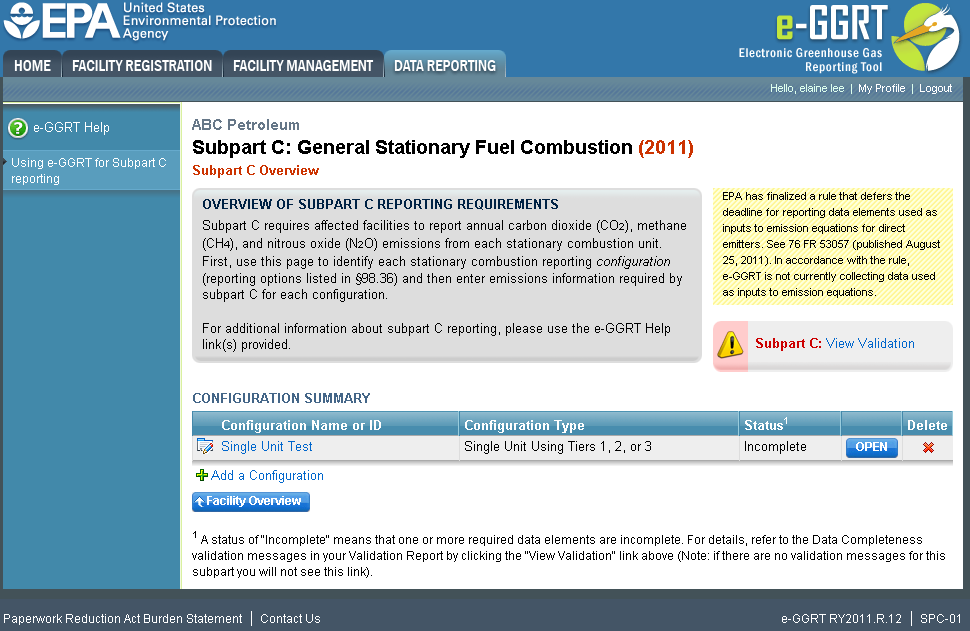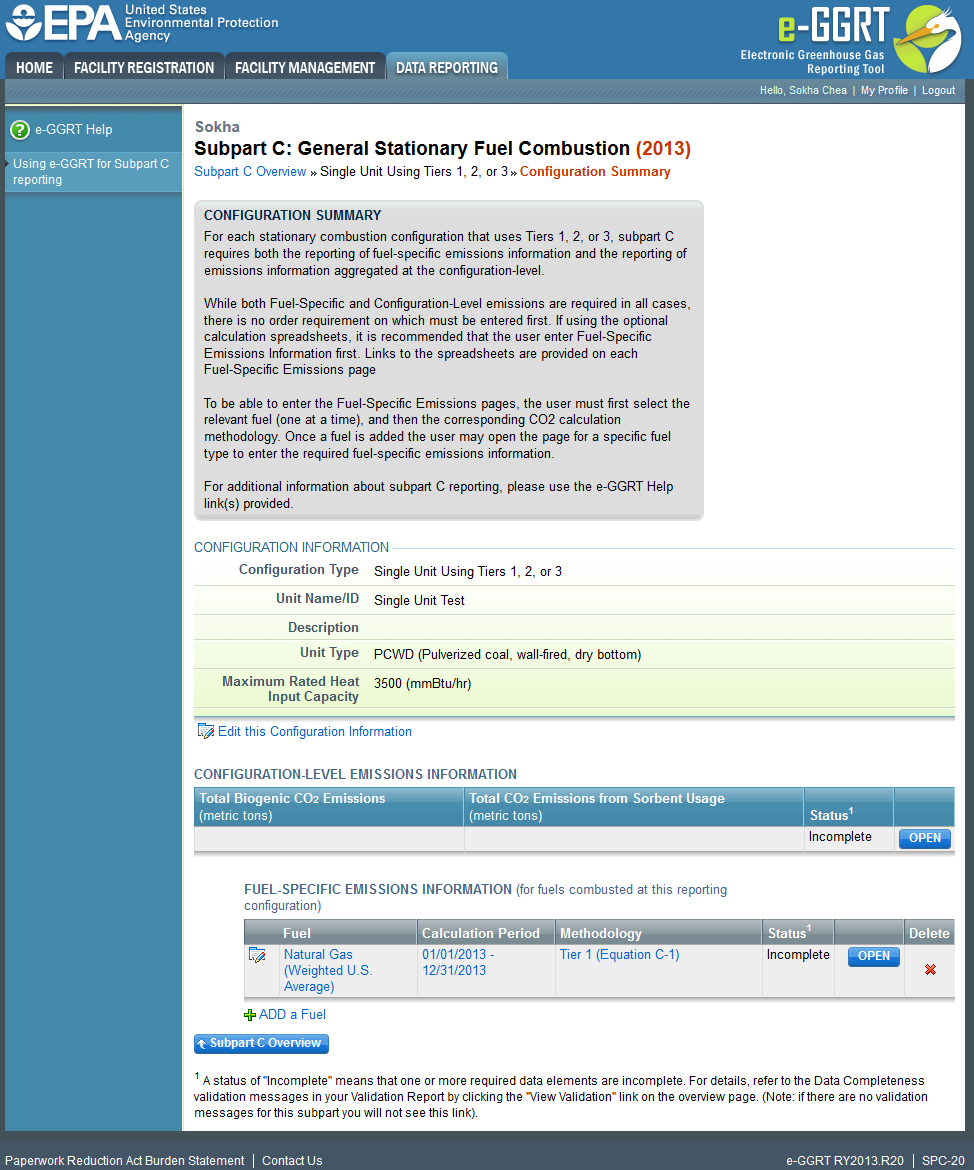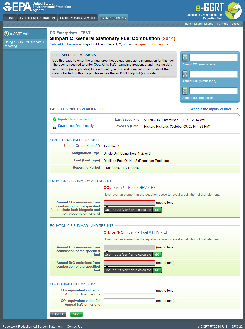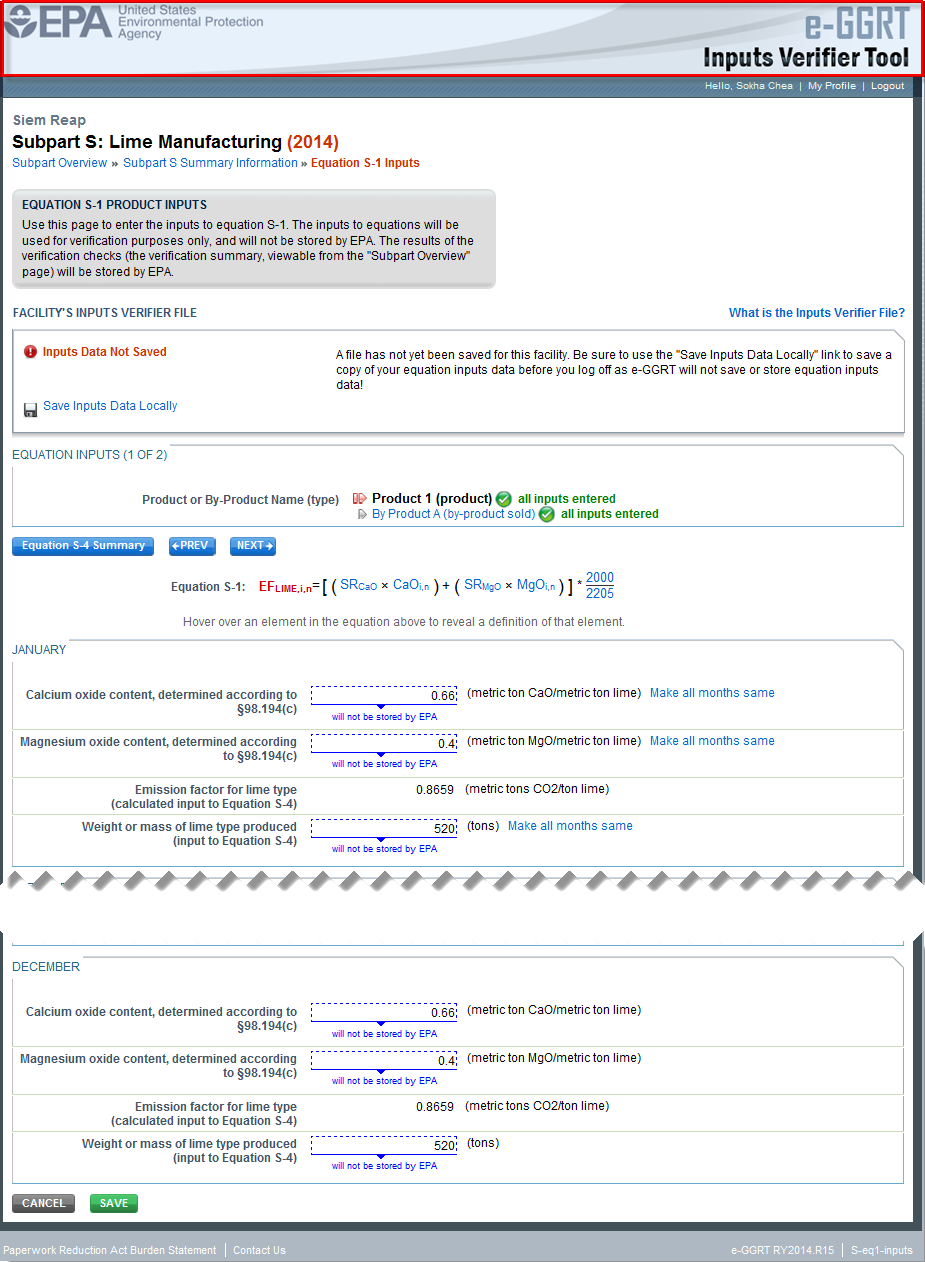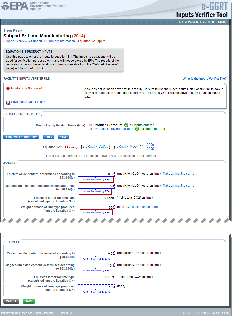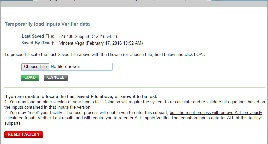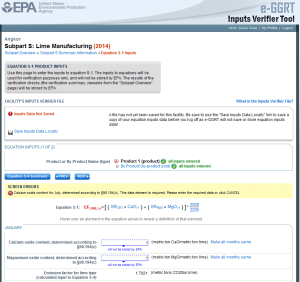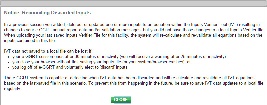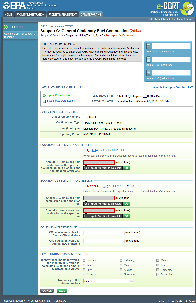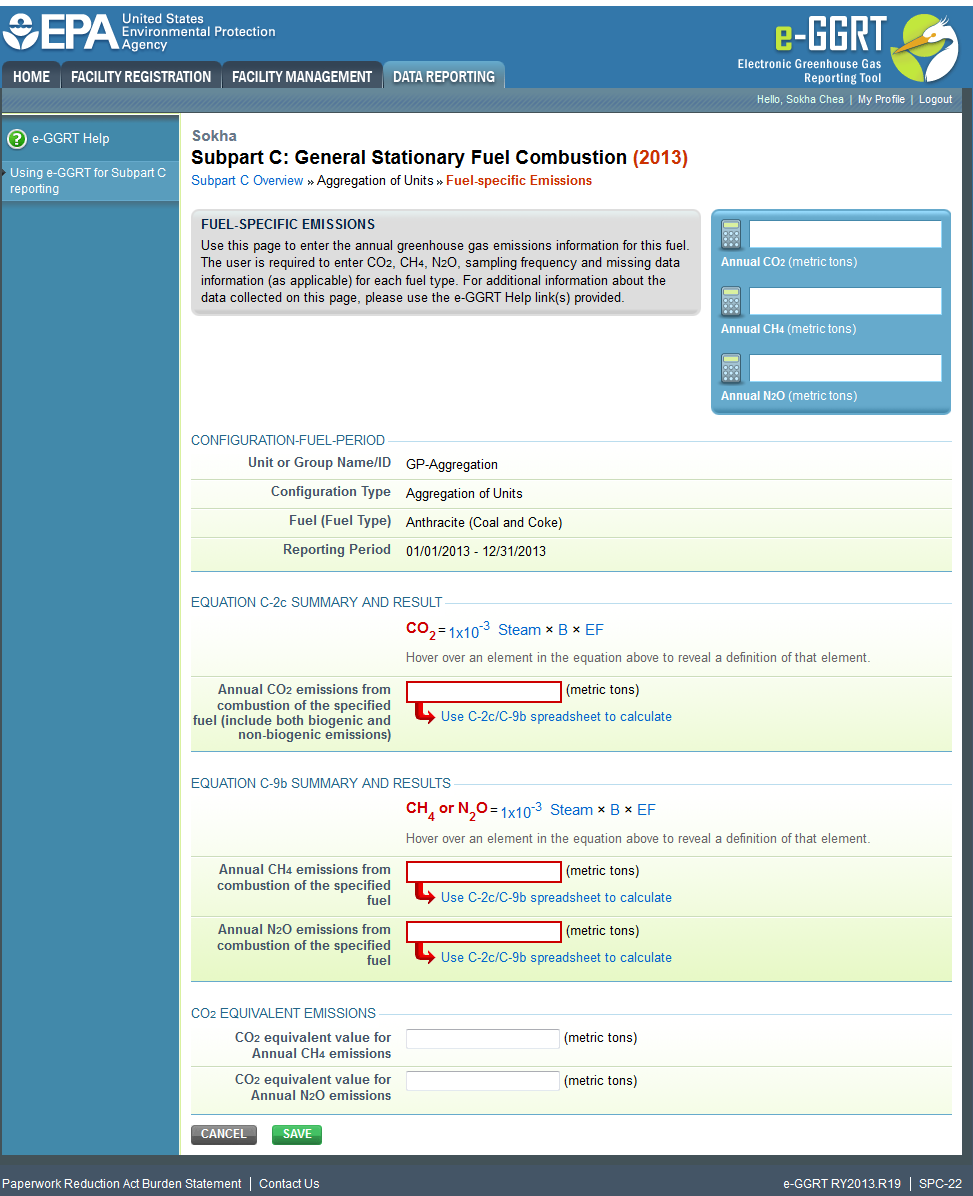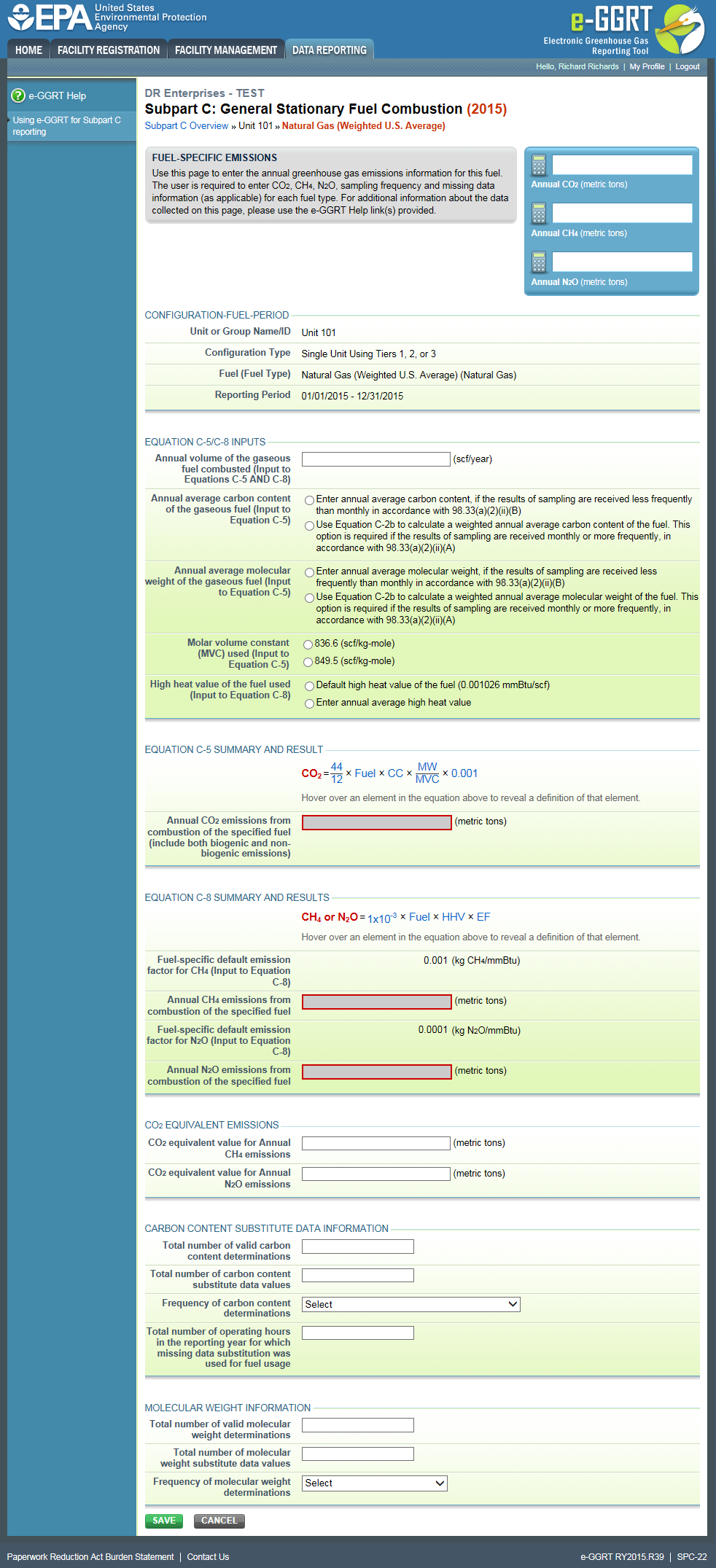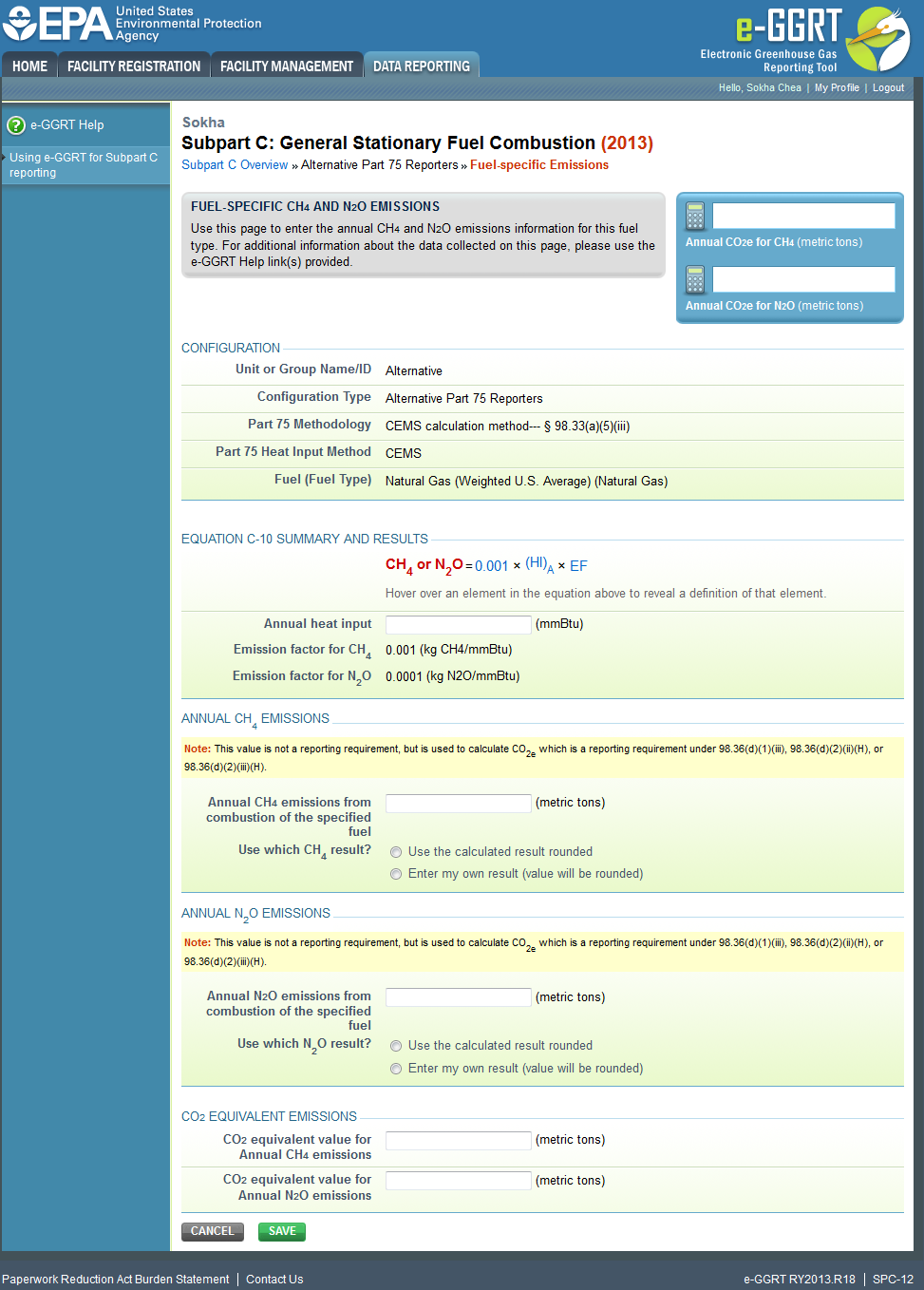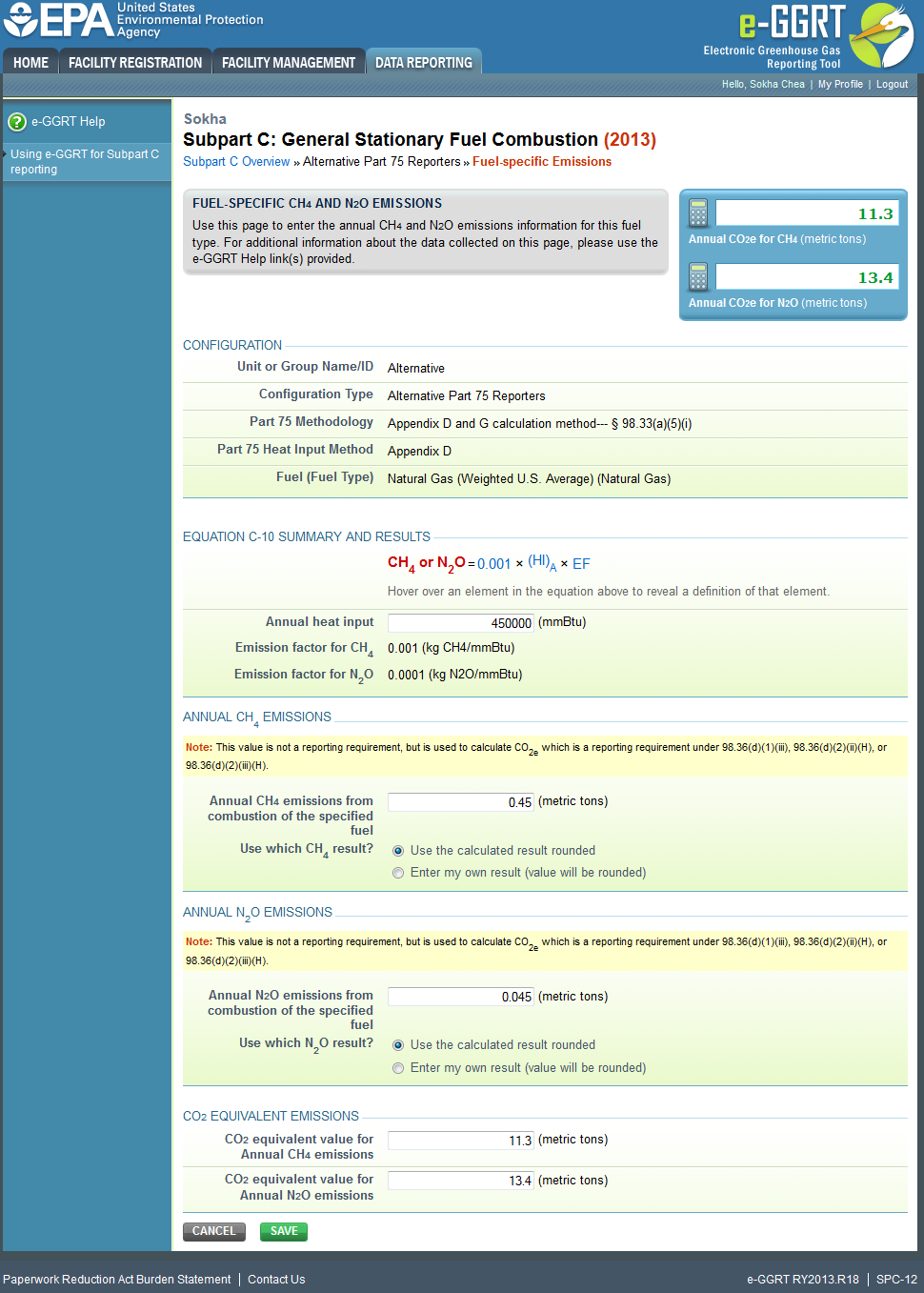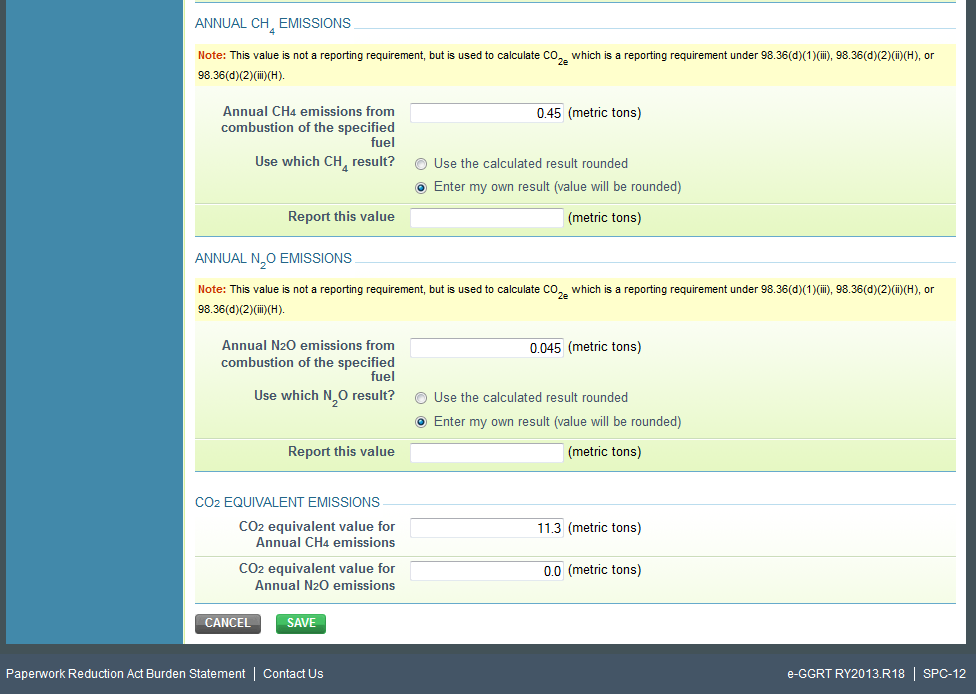This page provides an overview of subtopics that are central to subpart C reporting:
- Configuration Identification Information
- Configuration-Level Emissions Information
- Fuel Identification Information
- Fuel-Level Emissions Information
- Subpart Validation Report
The end of the page contains links you can use for more information on these topics.
Configuration Identification Information
For stationary combustion sources required to report under subpart C, e-GGRT requires you to identify which reporting option each unit or group of units will use to report emissions. The different subpart C reporting options are referred to as “Configurations” in e-GGRT. The individual configurations are designed to match the reporting options made available by the rule in 40 CFR 98.36. As specified in part 98, each configuration has slightly different reporting requirements. Once a configuration is added, e-GGRT will allow you to enter the required reporting elements for the configuration type selected. A facility may have multiple configuration types and/or multiple configurations of any given type. A single unit may not be reported under multiple configurations.
Click this link to expand Starting on the Subpart C Overview page, click the link titled "ADD a Configuration" below the CONFIGURATION SUMMARY table.
Click this link to expand The unit or group configuration types are first briefly identified below with the relevant regulatory citation, and then again in more detail: The single unit reporting configuration is the most basic configuration type. Any unit may be reported individually in e-GGRT. If the unit uses Tiers 1, 2, or 3 to calculate CO2 emissions, Configuration Type 1 must be used. A unit under Configuration Type 1 may combust multiple fuels, and it is possible for each fuel to use a different tier. For example, a unit that has a maximum rated heat input capacity of 500 mmBtu/hr is generally required to use Tier 3 for coal, but may use Tier 1 or Tier 2 for natural gas. Configuration Type 2 is the reporting option for a single unit that is either required, or elects to use Tier 4 (CEMS). CO2 emissions are reported for all fuels combined, but CH4 and N2O emissions are reported individually for each fuel. If a unit changes its calculation methodology to Tier 4 during the year, the unit will need to be added as two separate configurations in e-GGRT with different configuration names. The aggregation of units option is a reporting configuration that allows multiple units to be reported as a single entity, provided that certain conditions are met. If this reporting option is selected, emissions from all of the units grouped in this configuration will be reported as combined emissions in e-GGRT. If a facility contains two or more units, each of which has a maximum rated heat input capacity of 250 mmBtu/hr or less, you may report these units as a Configuration Type 3 in e-GGRT, provided that only Tiers 1-3 are used and the units use the same tier for any common fuels combusted. Fuels of different types may use different tiers, as permitted. There is no limit on the number of units that may be included in this configuration provided the previous criteria are met. While the use of Tier 3 is permitted in an aggregation of units configuration, it is not common for configurations of this type as Tier 3 is generally required only for larger units (i.e., greater than 250 mmBtu/hr) that are not eligible for the aggregation of units reporting option. The common pipe reporting configuration is another alternative reporting option that allows for multiple units to be reported as a single group entry. This configuration is different from the aggregation of units configuration in that there is no size constraint. The common pipe configuration may only be used if two or more stationary combustion units at a facility combust the same type of liquid or gaseous fuel and the fuel is fed to the individual units through a common supply line or pipe. The common pipe configuration may only be used if the units only combust the liquid or gaseous fuel supplied by the common pipe. Units that combust fuel other than the fuel supplied by the common pipe must be accounted for under a separate configuration since a single unit may not be reported under multiple configurations. For example, a unit that burns coal and natural gas may not be included in a common pipe configuration for units that only combust natural gas. In such a situation, you may report the units that only combust natural gas as a common pipe configuration and report the unit that combusts coal and natural gas under a separate configuration. To calculate emissions for the common pipe, you may use company records to subtract the quantity of gas diverted to the gas/coal unit from the quantity of gas measured for the common pipe. The diverted gas would need to be accounted for in a separate configuration for the coal/gas-fired unit. If the gas was diverted offsite or to an exempt unit, then it would not have to be accounted for in the facility’s annual GHG report and may also be subtracted, using company records, from the fuel measured for the common pipe. The tier required for the common pipe configuration is based on the maximum rated heat input capacity of the largest unit served by the common pipe. If multiple units vent to a common stack or duct and Tier 4 is used to calculate the CO2 emissions for those units, the common stack configuration must be used. This configuration represents the alternative calculation and reporting requirements available to certain units that report heat input year-round to EPA according to part 75. Units subject to subpart D (electricity generating units that are subject to the Acid Rain Program or EGUs that are otherwise required to monitor and report to EPA CO2 emissions year-round according to Part 75) are not be eligible to report under this option. Units subject to subpart D should report following the instructions for subpart D. If this option is selected in place of using one of the 4 tiers, the applicable calculation methodology specified in 98.33(a)(5) must be used to calculate CO2 emissions and the reporting requirements specified in 98.36(d)(2) replace the requirements specified in 98.36(b).Adding Configurations
Configuration Type 1 - Single Unit Using Tiers 1, 2, or 3 [98.36(b)]
Configuration Type 2 – Single Unit Using Tier 4 [98.36(b)]
Configuration Type 3 – Aggregation of Units [98.36(c)(1)]
Configuration Type 4 – Common Pipe [98.36(c)(3)]
Configuration Type 5 – Common Stack [98.36(c)(2)]
Configuration Type 6 – Alternative Part 75 Reporters [98.36(d)(2)]
Configuration-Level Emissions Information
Once a configuration is added, the user will be prompted to input information that serves to identify the configuration. The identification elements are listed below for each configuration type:
Note: Configuration Type 1 pictured.
Click this link to expand
For configurations of Type 1 (single unit using Tiers 1, 2, or 3), subpart C requires the following additional configuration-level information: For configurations of Type 3 (aggregation of units), subpart C requires the following additional configuration-level information: For configurations of Type 1 (single unit using Tiers 1, 2, or 3) and Type 3 (aggregation of units), subpart C requires to identify whether CO2 emissions are generated from operations using sorbent injection that are not monitored using CEMS by selecting the "Yes" or "No" radio buttons for "Is CO2 emission generated from operations using sorbent injection which are not monitored using CEMS?" If "Yes" is selected, the following information must be reported in the fields provided:
Click this link to expand
For configurations of Type 1 (single unit using Tiers 1, 2, or 3) and Type 3 (aggregation of units), regardless of Tier or CO2 methodology selected, additional information must be reported at the configuration level if municipal solid waste (MSW) is combusted and ASTM methods D7495-08 and D6866-08 are used to determine the biogenic portion of the annual CO2 emissions, as described in 98.34(d) or if the unit co-fires biogenic fuels (or partly-biogenic fuels) and non-biogenic fuels and ASTM methods D7495-08 and D6866-08 are used to determine the biogenic portion of the annual CO2 emissions, as described in 98.34(e). In the Biogenic CO2 Verification Data section, use the checkboxes to indicate that the biogenic portion of the annual CO2 emissions was determined in accordance with 98.34(d) or 98.34(e), as applicable, and, provide the sample analysis results for each quarter as a decimal fraction. [98.36(e)(2)(x)(A), 98.36(e)(2)(xi)]
Click this link to expand
For configurations of Type 4 (common pipe), subpart C requires the following additional configuration-level information: Use the text boxes to enter the required information for your configuration type. For configurations of Type 4 (common pipe), regardless of Tier or CO2 methodology selected, additional information must be reported at the configuration level if the unit co-fires biogenic fuels (or partly-biogenic fuels) and non-biogenic fuels, and ASTM methods D7495-08 and D6866-08 are used to determine the biogenic portion of the annual CO2 emissions, as described in 98.34(e). In the Biogenic CO2 Verification Data section, use the checkboxes to indicate that the biogenic portion of the annual CO2 emissions was determined in accordance with 98.34(e), and, provide the sample analysis results for each quarter as a decimal fraction. [98.36(e)(2)(xi)] When finished, click SAVE.
Click this link to expand
For configurations of Type 2 (single unit using Tier 4) and Type 5 (monitored common stack or duct configurations), subpart C requires the following additional information aggregated at the configuration level: If biogenic CO2 emissions were estimated using the methodology described by Equations C-12, C-13, and C-14, the following additional information is required by subpart C for configurations of Type 2: Use the text boxes and check box to enter the required information for your configuration type. For configurations of Type 2 (single unit using Tier 4) and Type 5 (monitored common stack or duct configurations), regardless of Tier or CO2 methodology selected, additional information must be reported at the configuration level if municipal solid waste (MSW) is combusted and ASTM methods D7495-08 and D6866-08 are used to determine the biogenic portion of the annual CO2 emissions, as described in 98.34(d), or, if the unit co-fires biogenic fuels (or partly-biogenic fuels) and non-biogenic fuels, and ASTM methods D7495-08 and D6866-08 are used to determine the biogenic portion of the annual CO2 emissions, as described in 98.34(e). In the Biogenic CO2 Verification Data section, use the checkboxes to indicate whether the biogenic portion of the annual CO2 emissions was determined in accordance with 98.34(d) or 98.34(e), and, provide the sample analysis results for each quarter as a decimal fraction. [98.36(e)(2)(x)(A), 98.36(3)(2)(xi)]
Click this link to expand
When finished, click SAVE.
Click this link to expand
For configurations of Type 6 (year-round Part 75 heat input reporters), subpart C requires the following additional information aggregated at the configuration level:Configuration Types 1, 3 and 4
Configuration Types 2 and 5
Configuration Type 6 (year-round Part 75 heat input reporters)
Fuel Identification Information
For configurations of all types, subpart C requires you to identify the following for each configuration: If a configuration type is selected that uses Tiers 1, 2, or 3, you will be required to specify which equation is used to calculate CO2 emissions. By identifying which equation is used to calculate emissions, e-GGRT is able to determine which data reporting elements are required for each fuel type. The reporter should refer to 98.33(b) to determine which Tier is required for each fuel type at the configuration. For Configurations of Type 1 (single unit using Tiers 1, 2, or 3), Type 3 (aggregation of units), and Type 4 (common pipe), subpart C requires you to identify the methods used to calculate emissions for each fuel type. Include the following information for each fuel type combusted in the unit:
Fuel-Level Emissions Information
Once the fuel types and CO2 calculation method are specified, e-GGRT will prompt the user for fuel specific emissions information. Although units using Tier 4 and alternative part 75 methods are not generally required to calculate fuel specific CO2 mass emissions, such units are required to report fuel specific CH4 and N2O mass emissions. Fuel specific missing data information is also reported in this section. The text below describes how to enter subpart C Stationary Fuel Combustion Sources fuel-level emissions information for each configuration type for RY2014 and later. The process to edit fuel information for an existing configuration type is essentially similar.
Click this link to expand
Starting on the Subpart C Overview page, find the configuration type for which you would like to enter emissions information in the CONFIGURATION SUMMARY table and click OPEN.
Click this link to expand
To enter emissions information by fuel type, find the fuel type for which you would like to enter fuel emissions data in the FUEL-SPECIFIC EMISSIONS INFORMATION table and click OPEN. How you report fuel-level emissions information will depend on whether or not you intend to enter equation inputs using the IVT module or report them through e-GGRT. The section below describes how to enter inputs into the IVT module. If you are required or choose to report equation inputs to EPA, see Reporting Emissions and Equation Inputs to EPA for instructions on how to report fuel-specific emissions. The data entry screen will vary depending on the calculation methodology (tier and equation). The screen shot below shows the Fuel-specific Emissions page for Tier 2 using Equation C-12a and C-9a to calculate CO2 emissions and Equation C-8 to calculate CH4 and N2O emissions.
Click image to expand Facilities access the IVT module from the Fuel-specific Emissions page. In the Equation Summary and Result Section for CO2, you will find a data entry cell for CO2 emissions. Immediately below this data entry cell you will see a block labeled "Use Inputs Verifier to calculate" and a green "Go" box. Click "Go" to open the IVT module for the methodology you have selected for the fuel. You can also access the IVT module by clicking on the "Go" box associated with the data entry cells for CH4 and N2O. (For fuels for which you use the Tier 4 methodology (CEMS), you must access the IVT using the CH4 and N2O "Go" boxes since there is no CO2 data entry cell on the Fuel-specific Emissions page for Tier 4. Also, if you are calculating emissions with the Tier 3 methodology for a gaseous fuel using Equation C-5, you must select the Molar Volume Constant (MVC) used at the bottom of the Fuel-specific Emissions page before you access the IVT module.) If you have previously entered these inputs and saved your inputs file locally you should import your locally saved inputs file. (You will be prompted to load data from an existing inputs file when you open subpart C on the Facility Overview page.) If you are having trouble locating your inputs file or would like to "Reset" and recreate your inputs file, please review our help content reviewing these processes at Saving and Reloading a Inputs Verifier File or Resetting your Facility To Create a New Inputs Verifier file. Once you enter the IVT module you will note that these screens are formatted with a grey background and an Inputs Verifier Tool header. Here you are asked to provide emissions inputs to allow the IVT to calculate emissions. These inputs will vary according to tier methodology used and whether the fuel is gaseous, liquid or solid. The screen shot below shows the IVT page for entering equation inputs for distillate fuel oil no. 2 using the Tier 1 method. The IVT data entry requirements for each tier are summarized below. For each fuel type (including biomass fuel(s))* for which you have elected to use a Tier 1 (Equation C-1, C-1a, or C-1b) methodology, the IVT requires you to enter the quantity of the fuel combusted: *When using Wood and Wood Residuals in non-IVT configuration, additional data is necessary. In place of the radio buttons for “High heat value of the fuel used” e-GGRT instead collects “moisture content used to calculate the wet-basis HHV” as a percent. Unit’s measure of “percent” and the value collected would be a value greater than or equal to zero and less than or equal to 100. This value will automatically be used to calculate a wet-basis HHV in mmBtu/short ton based on the default dry-based HHV for Wood and Wood Residuals. When finished, click SAVE. For each fuel type (including biomass fuel(s)) for which you have elected to use a Tier 2 (Equations C-2a and C-2b) methodology, the IVT requires you to enter the following: *Depending on the unit(s)’ size and fuel sampling frequency requirements, you may be required to use Equation C-2b to calculate the fuel volume and high heat value of the fuel used. Specifically, if the unit (or largest unit in the configuration) is at least 100 mmBtu/hr, and, the fuel sample results are obtained at least monthly, you must use Equation C-2b. If these requirements are not met, you have the option of either using Equation C-2b to calculate an average HHV, or, calculating an arithmetic average HHV. In either optional case, you will calculate the annual average HHV offline and enter the value directly into the IVT. Access the Equation C-2b IVT by selecting the radio button labeled "Use Equation C-2b to calculate a weighted annual average high heat value of the fuel" and clicking on the "Go" button associated with the data entry cell that appears. The equation C-2b IVT requires entry of the following for each month of the reporting year: For municipal solid waste (MSW) for which you have elected to use the Tier 2, Equation C-2c methodology, the IVT requires you to enter the following: For each fuel type (including biomass fuel(s)) for which you have elected to use a Tier 3 (Equations C-3, C-4 and C-5) methodology, the IVT requires you to enter the following: *Access the Equation C-2b IVT by selecting the radio button labeled "Use Equation C-2b to calculate a weighted annual average high heat value of the fuel" and clicking on the "Go" button associated with the data entry cell that appears. The equation C-2b IVT requires entry of the following for each month of the reporting year: For each fuel type (including biomass fuel(s)) for which you use the Tier 4 methodology, subpart C requires you to enter the Cumulative annual heat input from combustion of the fuel (mmBtu) to allow the IVT to calculate CH4 and N2O emissions using Equation C-10. Once you have completed entering all of your inputs for the fuel in the IVT, click “Save” at the bottom of the page and e-GGRT will calculate your emissions and return you to the Fuel-specific Emissions page where the emissions of CO2, CH4, and N2O calculated for the fuel is displayed in the respective data entry cell for each gas. The CO2e for CH4 and N2O emissions will also be displayed on this page. Check the “Enter/Report Alternate Result” box if you wish to report a result that differs from the one calculated by the IVT (note that this will generate a validation message). For Tier 2 and Tier 3 methodology, you are required to report monitoring information in sections below the equation summary and results sections (see Reporting Fuel-specific Monitoring Information below). When you have finished entering data on the Fuel-specific Emissions page, click "Save," which will return you to the Configuration Summary page. As you enter data into the Inputs Verifier Tool (IVT), the system creates and "inputs file" that contains all the data that you entered into IVT. You must save your inputs file to your computer or other location that you designate. On each subsequent log in, you will be prompted to temporarily upload the latest version of the inputs file to e-GGRT. e-GGRT will not save data entered into the IVT. Users are responsible for saving their facility’s inputs file. This page shows how the IVT assists users with this task. The following example demonstrates how the inputs to equations are 1) entered, 2) saved locally, 3) temporarily loaded at a later session, 4) the screen errors you may receive, and 5) error messages you may receive if you attempt to open an inputs file that is not the most recent one saved for your facility. If you are having trouble locating your inputs file or would like to "Reset" and recreate your inputs file, please review our help content reviewing these processes at Reloading Your Inputs Verifier File or Resetting your Facility To Create a New Inputs Verifier file. To access the inputs verifier tool, users would log in to e-GGRT with their username and password, select their facility, and navigate to the "Data Reporting" section of e-GGRT.
Click this link to expand On the Data Reporting tab for the selected subpart, immediately below a reported emissions value, the user will find a button labeled "Use Inputs Verifier to calculate| GO". Clicking GO will open the inputs verifier tool for that reported emissions value. Please note that screens in the inputs verifier tool are clearly marked with a unique header indicating that you are using the IVT (shown below with red outline).
Click this link to expand Once in the IVT, the user will be able to enter inputs to equations data. An example of an inputs to equations field is outlined with red in the screen shot below. Please note that every field for inputs to equations states that the data "will not be stored by EPA". Unless you save you input files, you will need to manually re-enter this data during future data entry sessions. The screenshot below is from Subpart S and is displayed as an example. The screen for other subparts may differ slightly.
Click this link to expand Data entered into the inputs verifier module are NOT saved in e-GGRT. Only the output values from the inputs verifier module are saved in e-GGRT. Therefore, each user/facility will have to save their inputs verifier file to their local hard drive and keep track of the file for future use. On the top of each IVT screen, immediately below the grey box, IVT will present the save status of your FACILITY'S INPUTS VERIFIER FILE (File History), which contains the data entered into the inputs verifier module. To use e-GGRT in the future for your facility, you must save this file in a place where you can access it. This status box is also available on the Facility Overview page. Prior to saving your inputs verifier file, this section of the screen will state "Inputs Data Not Saved" in red letters and will provide the "Last Saved File" field. Click "Save Inputs Data" to save the inputs verifier file to your computer. This status box appears on many pages throughout e-GGRT and IVT so that it is easy for you to save inputs. However, you only need to save inputs at the completion of each data entry session. After clicking "Save Inputs Data ", you will be able to save the inputs verifier file to your computer. Please note that different browsers may allow the user to set file-saving preferences and default locations. The example shown below uses the Firefox browser. Each user’s save dialog box and defaults may appear differently, depending on the browser used. For information on browser-specific behaviors please refer to Browser-specific issues and behaviors.
Click this link to expand Once you have saved the file, the inputs verifier file status box will display “Inputs Data Saved” in green text and the "Saved By (Date):" field that shows the name of the user who most recently saved an inputs verifier file and the date and time.” Each time you click “Save Inputs Data Locally”, the IVT will record that you have saved your inputs verifier file. The IVT does not record where you save your inputs verifier file or whether you elect to cancel this action. When you come back to e-GGRT in a later session, you will return to the FACILITY or SUPPLIER OVERVIEW web form. Here you will see the box for the FACILITY'S INPUTS VERIFIER FILE (File History), with the message that “Inputs Data Not Loaded” in red text. To load an inputs verifier file that has been previously saved, click the link labeled "Temporarily Load Inputs Data". Then browse to and select the inputs verifier file saved locally (to your local computer or local network drive). The IVT will accept the ZIP file or XML file previously downloaded by the user or a copy of that file (note: this file may be renamed but its contents must be identical). Finally, click the IMPORT button to load the file to the inputs verifier tool.
Click this link to expand If the user attempts to reload an inputs verifier file that is not the one most recently saved for the facility, the user will receive the following warning message. The system prevents the user from accidentally loading an outdated file and thus losing the most recent data. Note that you may elect to choose "I Would Like to Upload this File" and the system will attempt to reconcile all validation messages and IVT calculations (which are based on the most recently-saved file) based on the inputs contained in the old file that you are electing to load. If you elect to proceed to upload an old file, it is highly recommended that you review all equation inputs and calculations to ensure your annual report is complete and accurate.
Click this link to expand
When attempting to save inputs data during the IVT data entry process, the user may receive screen errors that indicate the user has not completely entered required data to the Inputs Verifier Tool. Screen errors must be corrected before you will be permitted to complete a save action. Once you have corrected these errors, IVT will be able to calculate the equation result and you will be able to save your inputs verifier file locally.
Click this link to expand If the user inputs and saves data in IVT, then adds, deletes, or updates one or more inputs to an equation in IVT without saving the inputs file locally and subsequently attempts to log out of e-GGRT, the following warning message will be displayed.
Click this link to expand
The user has three options: If the user clicked the LOGOUT - DISCARD EQUATION INPUTS DATA button in a previous session, the following message will be displayed the next time the user logs in.
Click this link to expand
To load an inputs verifier file that has been previously saved (as would occur if you logged off and came back to e-GGRT in a later session), the user would click the link labeled "Temporarily Load Inputs Data". The user would browse to and select the inputs verifier file saved locally (to their local computer or local network drive). The IVT will accept the ZIP file or XML file previously downloaded by the user or a copy of that file (note: this file may be renamed but its contents must be identical) . The user would then click the IMPORT button to load the file to the inputs verifier tool. If you attempt to reload an inputs verifier file that is not the one most recently saved for the facility, the user will receive the following warning message. The system prevents the user from accidentally loading an outdated file and thus losing the most recent data. Note that you may elect to choose "I Would Like to Upload this File" and the system will attempt to reconcile all validation messages and IVT calculations (which are based on the most recently-saved file) based on the inputs contained in the old file that you are electing to load. If you elect to proceed to upload an old file, it is highly recommended that you review all equation inputs and calculations to ensure your annual report is complete and accurate. For fuels for which you have elected to use Tier 2 or Tier 3 methodologies, you are also required to report monitoring information in sections below the equation summary and results sections. For Tier 2, you are required to report the following HHV Substitute Data Information for all fuels:
Click image to expand For Tier 3, you are required to report the following Carbon Content Substitute Data Information for all fuels: For gaseous fuels that use the Tier 3 methodology, you are also required to report the following:
Click image to expand The data entry screen will vary depending on the calculation methodology (tier and equation). The screen shot below shows the Fuel-specific Emissions page for Tier 1 using Equation C-1 to calculate CO2 emissions and Equation C-8 to calculate CH4 and N2O emissions.
For each fuel type (including biomass fuel(s))* for which you have elected to use the Tier 2 (Equation C-2a)) methodology, subpart C requires you to report the following information by fuel type: Use the red-bordered text boxes to enter the required emissions information. To calculate the emissions you have the option of using your own resources or alternatively you may use the following tool and set of instructions: There are no associated reporting requirements for Equation C-2b, which is used to calculate the average HHV when multiple values are available. Use the check boxes, plain text box, and drop-down menu to enter the remaining required emissions information. *When using Wood and Wood Residuals in non-IVT configuration, additional data is necessary. In place of the radio buttons for “High heat value of the fuel used” e-GGRT instead collects “moisture content used to calculate the wet-basis HHV.” Unit’s measure of “percent” and the value collected would be a value greater than or equal to zero and less than or equal to 100. This value will automatically be used to calculate a wet-basis HHV in mmBtu/short ton based on the default dry-based HHV for Wood and Wood Residuals. When finished, click SAVE.
Click this link to expand
For each fuel type (including biomass fuel(s)) for which you have elected to use the Tier 2 (Equation C-2c) methodology, subpart C requires you to report the following information by fuel type: Use the red-bordered text boxes to enter the required emissions information. To calculate the emissions you have the option of using your own resources or alternatively you may use the following tool and set of instructions: When finished, click SAVE. Note: Equation C-5 pictured, Equations C-3 and C-4 will not include the MOLECULAR WEIGHT INFORMATION and MOLECULAR VOLUME CONSTANT sections
Click this link to expand For each fuel type (including biomass fuel(s)) for which you have elected to use a Tier 3 (Equation C-3, C-4, or C-5) methodology, subpart C requires you to report the following information by fuel type: For each gaseous fuel at each configuration for which you have elected to use the Tier 3 (Equation C-5) methodology, subpart C requires you to report the following additional information: Use the red-bordered text boxes to enter the required emissions information. To calculate the emissions you have the option of using your own resources or alternatively you may use the following tool and set of instructions: When finished, click SAVE.
Click this link to expand
When a Tier 4 (CEMS) configuration is selected, you are required to report the following information for each fuel type listed in Table C-2 (including biomass fuel(s)): Use the red-bordered text boxes to enter the required emissions information. To calculate the emissions you have the option of using your own resources or alternatively you may use the following tool and set of instructions: When finished, click SAVE.
Click this link to expand
For configurations using the alternative CO2 mass emissions calculation methods provided in 98.33(a)(5) (Year-round Part 75 heat input reporters), subpart C requires the entry of the total heat input for each fuel type listed in Table C-2 combusted in each unit (except as otherwise provided in 98.33(c)(4)(ii)(B)) in units of mmBtu. Enter this value in the text box provided under Equation C-10 Summary and Results. [98.36(d)(2)(ii)(G) and 98.36(d)(2)(iii)(G)] e-GGRT will calculate CH4 and N2O emissions from the total heat input entered using Equation C-10 and display the results under Annual CH4 Emissions and Annual N2O Emissions, respectively. [98.36(d)(2)(ii)(H) and 98.36(d)(2)(iii)(H)] If you calculated CH4 and N2O emissions for a blended fuel according to 98.33(c)(6)(ii), you can override the automatically calculated emissions values by selecting the "Enter my own result (value will be rounded)" radio buttons under Annual CH4 Emissions and Annual N2O Emissions. Enter the CH4 and N2O values you calculated in the "Report this value" fields.
Click this link to expand
Reporting Emissions By Entering Equation Inputs Using the IVT
Entering Data Using the IVT
Tier 1 (Equation C-1, C-1a, or C-1b)
Tier 2 (Equations C-2a and C-2b)
Tier 2 (Equation C-2c)
Tier 3 (Equation C-3, C-4, or C-5)
Tier 4 (CEMS)
Saving and Reloading Your Inputs Verifier File
Entering Data Using the IVT
Saving Data Entered in the IVT
Reloading an Inputs Verifier File
Screen Errors You May Receive
Reporting Fuel-specific Monitoring Information
Reporting Emissions and Equation Inputs to EPA
Click this link to expand
Tier 2 (Equation C-2c)
Tier 3 (Equation C-3, C-4, or C-5)
Tier 4 (CEMS)
Year-Round Part 75 Heat Input Reporters
Subpart Validation Report
The Validation Report assists you with determining the completeness and quality of your reported data. We strongly encourage you to use the Validation Report to check your work. The Validation Report performs two types of checks: Certain validation checks which are considered to represent critical errors must be corrected before you can successfully generate and submit your Annual Report. These checks are signified with a stop sign . If you feel that you have triggered one of these critical “stop signs” checks in error, or if there’s a reason why your report should be submitted despite the check being triggered, please submit a request to the e-GGRT Help Desk at GHGReporting@epa.gov. You may view the Validation Report at any time. Note that the Validation Report is intended to assist users in entering data, but it is not an indication that the reporter has entered all necessary information, nor is it an indication that the reporter is in compliance with part 98. Furthermore, a negative finding on the validation report is not a guarantee that a data element was entered incorrectly. For more detail on the Validation Report and its functionality please review the Subpart Validation Report page.
See Also
Screen Errors
Using e-GGRT to Prepare Your Subpart C Report for RY2014 and Later
Subpart C Configurations for RY2014 and Later
Subpart C Configuration-Level Emissions Information for RY2014 and Later
Subpart C Fuel Identification Information for All Reporting Years
Subpart C Fuel-Level Emissions Information for RY2014 and Later
Configuration types, emission details and their presentation in the summary report
Subpart C IVT Equation Inputs Summary
Using Subpart C Calculation Spreadsheets
Subpart Validation Report


